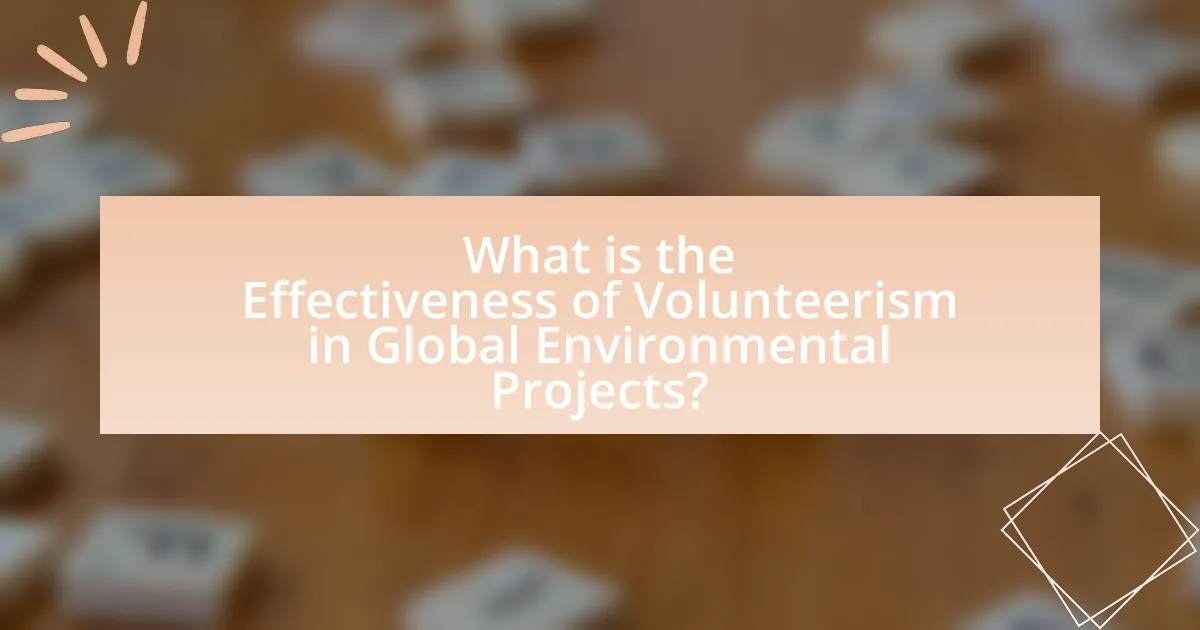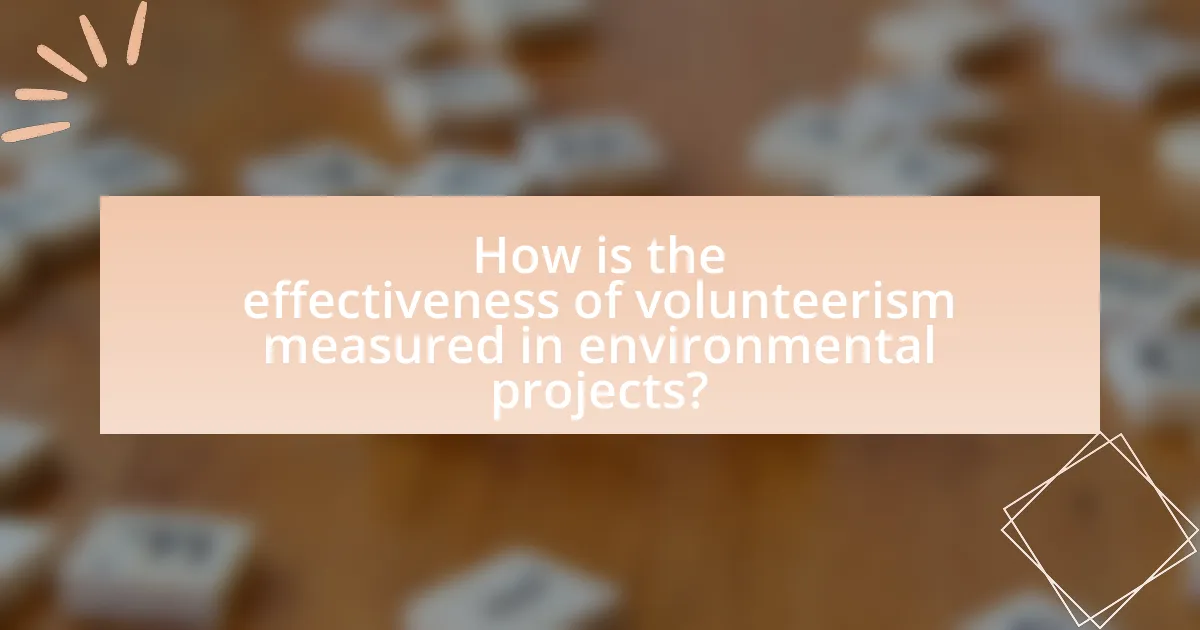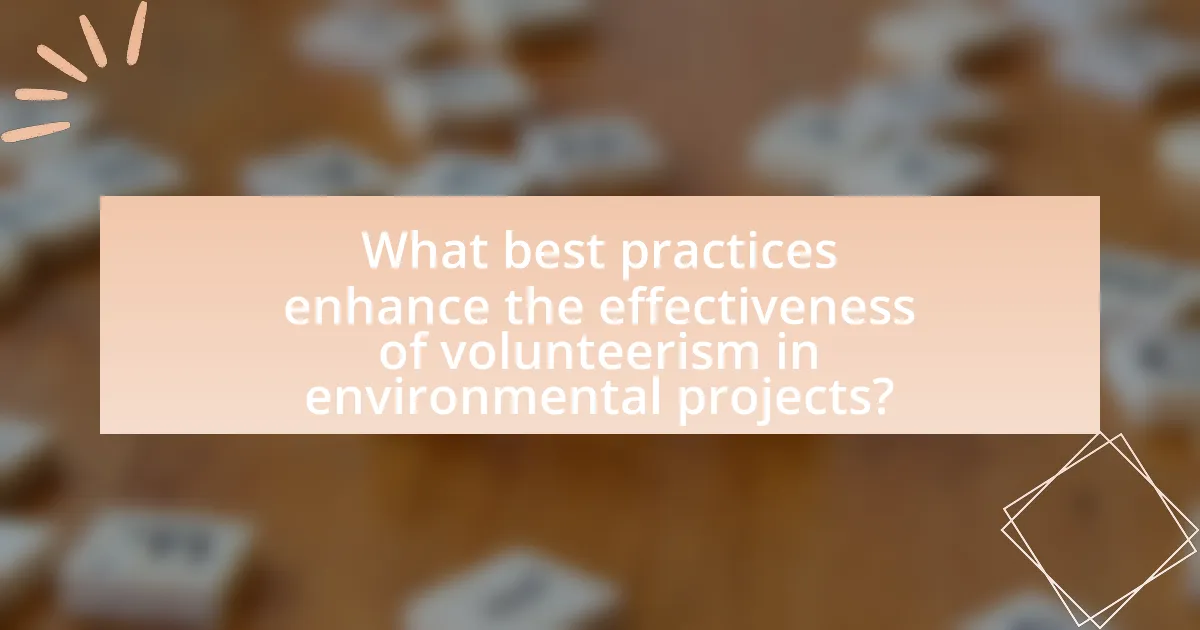The article examines the effectiveness of volunteerism in global environmental projects, highlighting its significant contributions to conservation, community engagement, and sustainability. It discusses how volunteer-led initiatives enhance biodiversity, restore ecosystems, and promote sustainable practices, supported by research findings that demonstrate measurable impacts, such as increased tree survival rates and reduced marine debris. The article also addresses the roles volunteers play, the challenges they face, and the motivations driving their participation, while emphasizing best practices for organizations to maximize volunteer impact and foster community engagement in environmental issues.

What is the Effectiveness of Volunteerism in Global Environmental Projects?
Volunteerism is highly effective in global environmental projects, significantly contributing to conservation efforts and community engagement. Research indicates that volunteer-led initiatives can enhance biodiversity, restore ecosystems, and promote sustainable practices. For instance, a study published in the journal “Environmental Management” found that volunteer programs in reforestation projects led to a 30% increase in tree survival rates compared to non-volunteer efforts. Additionally, volunteers often raise awareness and educate local communities about environmental issues, fostering long-term behavioral changes that benefit the environment. This dual impact of immediate ecological benefits and sustained community involvement underscores the effectiveness of volunteerism in addressing global environmental challenges.
How does volunteerism contribute to environmental sustainability?
Volunteerism contributes to environmental sustainability by mobilizing individuals to engage in conservation efforts, restoration projects, and community education initiatives. These activities directly enhance biodiversity, reduce pollution, and promote sustainable practices. For instance, a study by the National Oceanic and Atmospheric Administration (NOAA) found that volunteer-led beach cleanups significantly reduced marine debris, which is crucial for protecting marine ecosystems. Additionally, volunteers often help plant trees, which can sequester carbon and improve air quality, further supporting environmental health. Thus, volunteerism plays a vital role in fostering sustainable practices and enhancing ecological resilience.
What roles do volunteers play in environmental projects?
Volunteers play crucial roles in environmental projects by contributing labor, expertise, and community engagement. They assist in activities such as tree planting, habitat restoration, and wildlife monitoring, which are essential for ecological health. For instance, a study by the National Park Service found that volunteers contributed over 1.5 million hours of service, resulting in significant improvements in park ecosystems. Additionally, volunteers often help raise awareness and educate the public about environmental issues, fostering a culture of sustainability. Their involvement not only enhances project outcomes but also builds community resilience and stewardship towards natural resources.
How do volunteer efforts impact local ecosystems?
Volunteer efforts positively impact local ecosystems by enhancing biodiversity, restoring habitats, and promoting environmental awareness. For instance, community-led tree planting initiatives can increase forest cover, which supports wildlife and improves air quality. Research indicates that volunteer programs, such as those organized by the National Park Service, have led to the restoration of over 1,000 acres of degraded land, demonstrating the tangible benefits of collective action. Additionally, volunteers often engage in educational outreach, fostering a culture of conservation that encourages sustainable practices within the community.
Why is volunteerism important for global environmental initiatives?
Volunteerism is crucial for global environmental initiatives because it mobilizes diverse individuals to contribute their time and skills towards conservation efforts. This collective action enhances the capacity of organizations to implement projects effectively, as evidenced by the 2019 report from the United Nations Environment Programme, which highlighted that volunteer-led initiatives can increase community engagement and awareness, leading to more sustainable practices. Furthermore, research indicates that volunteerism fosters a sense of ownership and responsibility among participants, which is essential for long-term environmental stewardship.
What are the key motivations for individuals to volunteer in environmental projects?
Individuals are primarily motivated to volunteer in environmental projects due to a desire to contribute to ecological preservation and community improvement. This motivation is often driven by a sense of responsibility towards the environment, as many volunteers recognize the urgent need to address issues such as climate change, biodiversity loss, and pollution. Research indicates that 70% of volunteers cite environmental concerns as a primary reason for their involvement, highlighting a strong connection between personal values and volunteer actions. Additionally, social factors, such as the opportunity to connect with like-minded individuals and build community ties, further enhance the motivation to engage in these projects.
How does volunteerism enhance community engagement in environmental issues?
Volunteerism enhances community engagement in environmental issues by fostering a sense of ownership and responsibility among participants. When individuals volunteer for environmental projects, they actively contribute to local initiatives, which increases their awareness and connection to environmental challenges. Research indicates that communities with high volunteer participation report greater collective action and improved environmental outcomes, as seen in studies like “The Role of Volunteerism in Environmental Stewardship” published in the Journal of Environmental Management. This study highlights that volunteer-driven projects not only mobilize resources but also create networks of engaged citizens who advocate for sustainable practices, thereby reinforcing community ties and promoting long-term environmental stewardship.
What challenges do volunteers face in global environmental projects?
Volunteers in global environmental projects face several significant challenges, including cultural differences, resource limitations, and logistical issues. Cultural differences can lead to misunderstandings and miscommunication, impacting collaboration and project outcomes. Resource limitations often hinder the ability to implement effective solutions, as volunteers may lack access to necessary tools, funding, or training. Logistical issues, such as transportation difficulties and varying local regulations, can complicate project execution and delay progress. These challenges can ultimately affect the overall effectiveness of volunteer efforts in addressing environmental issues globally.
What are the common barriers to effective volunteer participation?
Common barriers to effective volunteer participation include lack of time, inadequate training, and insufficient organizational support. Many potential volunteers face time constraints due to personal or professional commitments, which limits their ability to engage in volunteer activities. Additionally, when organizations do not provide adequate training, volunteers may feel unprepared or uncertain about their roles, leading to decreased participation. Furthermore, a lack of organizational support, such as poor communication or insufficient resources, can discourage volunteers from committing to projects. Research indicates that these barriers significantly impact volunteer retention and engagement, highlighting the need for organizations to address these issues to enhance volunteer participation in global environmental projects.
How can organizations support volunteers in overcoming these challenges?
Organizations can support volunteers in overcoming challenges by providing comprehensive training and resources tailored to the specific needs of the volunteers. This approach ensures that volunteers are well-equipped with the necessary skills and knowledge to effectively contribute to environmental projects. For instance, a study by the National Council for Voluntary Organizations found that organizations that offer structured training programs see a 30% increase in volunteer retention rates. Additionally, organizations can facilitate open communication channels, allowing volunteers to express concerns and seek guidance, which fosters a supportive environment. By implementing these strategies, organizations can enhance volunteer effectiveness and satisfaction in global environmental initiatives.

How is the effectiveness of volunteerism measured in environmental projects?
The effectiveness of volunteerism in environmental projects is measured through various quantitative and qualitative metrics. Quantitative metrics include the number of volunteer hours contributed, the area of land restored or protected, and the volume of waste collected or recycled. Qualitative metrics assess volunteer satisfaction, community engagement, and the long-term impact on local ecosystems. For instance, a study by the National Park Service found that volunteer programs led to a 30% increase in park maintenance efficiency, demonstrating a direct correlation between volunteer involvement and project outcomes. Additionally, surveys and feedback mechanisms are often employed to gauge volunteer experiences and the perceived impact of their contributions on environmental sustainability.
What metrics are used to evaluate volunteer impact?
Metrics used to evaluate volunteer impact include the number of hours volunteered, the number of beneficiaries served, and the qualitative feedback from participants and community members. These metrics provide quantifiable data on volunteer engagement and the direct effects of their contributions. For instance, tracking volunteer hours can demonstrate the scale of commitment, while beneficiary counts can indicate the reach of the volunteer efforts. Qualitative feedback, such as surveys or interviews, offers insights into the perceived value and effectiveness of the volunteer work, highlighting areas for improvement and success stories.
How do qualitative and quantitative measures differ in assessing volunteer contributions?
Qualitative and quantitative measures differ significantly in assessing volunteer contributions by focusing on distinct aspects of the volunteer experience. Qualitative measures evaluate the subjective experiences, motivations, and personal impacts of volunteers through interviews, open-ended surveys, and narrative accounts, providing insights into the emotional and social dimensions of their contributions. In contrast, quantitative measures assess the tangible outputs of volunteer work, such as hours contributed, number of projects completed, or the amount of resources generated, often utilizing statistical analysis to quantify the impact. For instance, a study by the Corporation for National and Community Service found that volunteers contributed approximately 4.1 billion hours of service in 2019, translating to an economic value of over $167 billion, illustrating the measurable impact of volunteerism. This distinction highlights how qualitative assessments capture the depth of volunteer experiences while quantitative assessments provide concrete data on their contributions.
What case studies illustrate successful volunteerism in environmental projects?
Successful volunteerism in environmental projects is illustrated by the case studies of the “Green Corps” program in the United States and the “WWOOF” (World Wide Opportunities on Organic Farms) initiative globally. The Green Corps program, which trains young people in environmental activism, has successfully mobilized over 1,000 volunteers to engage in hands-on conservation projects, resulting in the restoration of over 1,500 acres of land and the planting of more than 100,000 trees since its inception in 1994. Similarly, WWOOF connects volunteers with organic farms, allowing them to work in exchange for food and accommodation. This initiative has facilitated sustainable agricultural practices across 130 countries, with over 100,000 volunteers participating annually, significantly contributing to local food systems and biodiversity conservation. These case studies demonstrate the tangible impact of organized volunteer efforts on environmental sustainability.
How does volunteerism influence policy and advocacy in environmental issues?
Volunteerism significantly influences policy and advocacy in environmental issues by mobilizing community engagement and raising awareness. Volunteers often serve as grassroots advocates, providing local insights that inform policymakers about pressing environmental concerns. For instance, studies show that volunteer-led initiatives, such as community clean-up events, can lead to increased public support for environmental regulations, as seen in the case of the Clean Water Act in the United States, where local advocacy groups played a crucial role in shaping policy through volunteer efforts. Additionally, volunteerism fosters collaboration between organizations and government entities, enhancing the effectiveness of advocacy campaigns aimed at environmental protection.
What role do volunteers play in shaping environmental legislation?
Volunteers play a crucial role in shaping environmental legislation by advocating for policy changes, raising public awareness, and providing grassroots support for environmental initiatives. Their involvement often leads to increased community engagement and pressure on lawmakers to prioritize environmental issues. For instance, organizations like Greenpeace and the Sierra Club mobilize volunteers to participate in campaigns that influence legislative processes, resulting in significant policy reforms such as the Clean Air Act and the Endangered Species Act. Research indicates that volunteer-driven movements can effectively sway public opinion and legislative outcomes, demonstrating the power of collective action in environmental advocacy.
How can volunteer initiatives lead to broader societal change?
Volunteer initiatives can lead to broader societal change by fostering community engagement and raising awareness about critical issues. When individuals participate in volunteer projects, they often develop a deeper understanding of social and environmental challenges, which can inspire collective action. For example, research from the Corporation for National and Community Service indicates that volunteers are more likely to engage in civic activities, such as voting and advocacy, after participating in community service. This increased civic engagement can result in policy changes and enhanced community resilience, demonstrating the transformative potential of volunteerism in addressing societal issues.

What best practices enhance the effectiveness of volunteerism in environmental projects?
Best practices that enhance the effectiveness of volunteerism in environmental projects include clear communication, structured training, and community engagement. Clear communication ensures that volunteers understand project goals and their roles, which increases motivation and efficiency. Structured training equips volunteers with necessary skills and knowledge, leading to more impactful contributions. Community engagement fosters local support and collaboration, which is essential for the sustainability of environmental initiatives. Research indicates that projects with strong community involvement see a 30% increase in volunteer retention rates, demonstrating the importance of these practices in achieving successful outcomes.
How can organizations effectively recruit and retain volunteers?
Organizations can effectively recruit and retain volunteers by implementing targeted outreach strategies and fostering a supportive environment. Targeted outreach includes utilizing social media platforms, community events, and partnerships with local organizations to attract individuals who are passionate about environmental causes. A supportive environment is created through clear communication, recognition of volunteer contributions, and opportunities for skill development. Research indicates that organizations with structured volunteer programs experience a 50% higher retention rate, demonstrating the importance of these strategies in maintaining volunteer engagement.
What strategies improve volunteer training and development?
Effective strategies to improve volunteer training and development include structured onboarding programs, ongoing skill development workshops, and mentorship initiatives. Structured onboarding programs provide volunteers with clear expectations and essential information about their roles, which enhances their confidence and effectiveness. Ongoing skill development workshops, such as training in environmental conservation techniques, ensure that volunteers remain engaged and knowledgeable about current practices. Mentorship initiatives pair experienced volunteers with newcomers, fostering a supportive learning environment that accelerates skill acquisition and retention. Research indicates that organizations implementing these strategies report higher volunteer satisfaction and retention rates, ultimately leading to more successful outcomes in environmental projects.
How can organizations foster a sense of community among volunteers?
Organizations can foster a sense of community among volunteers by creating structured opportunities for interaction and collaboration. This can be achieved through regular team-building activities, social events, and collaborative projects that encourage volunteers to work together towards common goals. Research indicates that social connections among volunteers enhance commitment and satisfaction, as seen in a study published in the Journal of Community Psychology, which found that volunteers who engaged in group activities reported higher levels of community belonging and motivation. By prioritizing these interactions, organizations can effectively strengthen the bonds among volunteers, leading to a more cohesive and engaged volunteer community.
What are the key takeaways for maximizing volunteer impact in environmental projects?
To maximize volunteer impact in environmental projects, organizations should focus on clear communication, effective training, and meaningful engagement. Clear communication ensures that volunteers understand project goals and their roles, which enhances motivation and effectiveness. Effective training equips volunteers with the necessary skills and knowledge, leading to higher quality outcomes in environmental initiatives. Meaningful engagement fosters a sense of ownership and commitment among volunteers, which has been shown to increase retention rates and overall project success. Research indicates that projects with structured volunteer programs see a 30% increase in successful outcomes compared to those without such frameworks.
How can volunteers ensure their efforts are sustainable and impactful?
Volunteers can ensure their efforts are sustainable and impactful by engaging in thorough planning, collaboration with local communities, and continuous evaluation of their projects. Effective planning involves setting clear, achievable goals that align with the needs of the community and the environment, which enhances the relevance and longevity of the initiatives. Collaborating with local communities ensures that the projects are culturally appropriate and supported by those directly affected, increasing the likelihood of sustained impact. Continuous evaluation allows volunteers to assess the effectiveness of their actions, make necessary adjustments, and share best practices, thereby fostering a cycle of improvement and sustainability. Research indicates that projects with community involvement and ongoing assessment have a higher success rate, as seen in the 2018 study by the International Journal of Volunteer Administration, which found that community-driven initiatives led to a 40% increase in project sustainability.
What resources are available for volunteers seeking to enhance their contributions?
Volunteers seeking to enhance their contributions can access various resources, including training programs, online platforms, and community networks. Training programs, such as those offered by organizations like the National Volunteer Center, provide skills development in areas like project management and environmental science. Online platforms, such as VolunteerMatch and Idealist, connect volunteers with opportunities that match their skills and interests, facilitating targeted contributions. Community networks, including local environmental groups, offer mentorship and collaboration opportunities, allowing volunteers to share experiences and best practices. These resources collectively empower volunteers to maximize their impact in global environmental projects.